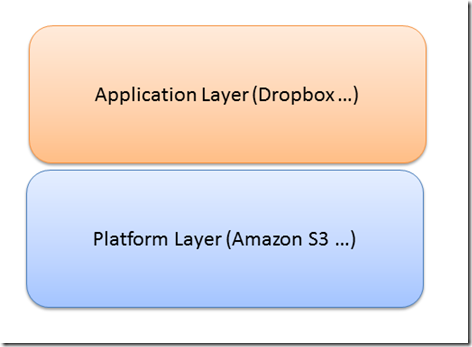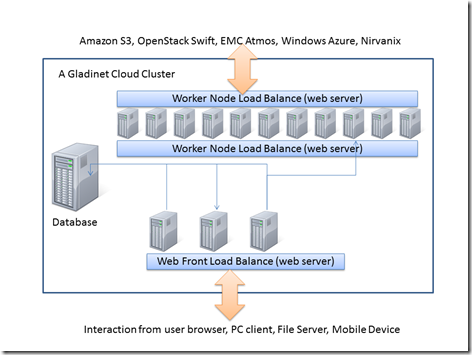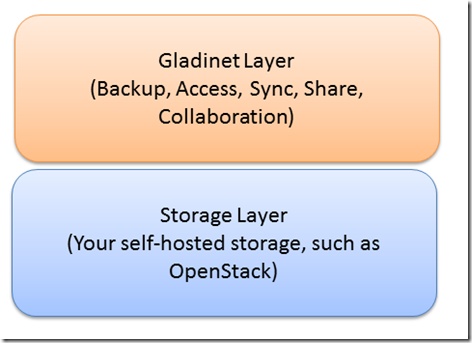Cloud Storage Middleware
As quoted from Wiki, Middleware is computer software that provides services to software applications beyond those available from the operating system.
We have seen the evolution of cloud computing and cloud storage. In terms of cloud storage service, Amazon S3 pretty much defines what cloud storage is. All the cloud storage services now are very similar to Amazon S3, whether it is Windows Azure Blob, EMC Atmos , Google Cloud Storage or OpenStack Swift Object Storage. These services have several things in common. First they are file (object) based. Second, they provide a set of very primitive API over HTTP, such as read file, write file, delete file and that is pretty much it. In a strict sense, cloud storage services referred to these services that provide the most primitive read/write functionality and solved the most important problem of redundancy and scalability. It is the platform layer.
We also see cloud storage referenced in a *loose* sense. For example, sometimes people refer to Dropbox, Box.net, Google Drive, Microsoft SkyDrive as cloud storage too. These are value-add services on top of raw cloud storage, adding sync, backup, access, mobile app support on top of primitive read/write operations. It is the application layer.

Since Dropbox and Box.net popularized the cloud storage use case, most notably, the two-way sync and mobile device support, it also created a market need for service providers to look for something like “self-hosted dropbox solution” or “self-hosted box.net solution” so they can provide dropbox or box.net like services to their own customer base.
Here comes the need for “Cloud Storage Middleware”, which is installable computer software that provides value-add such as backup, access, sync & share, identity and controlled collaboration on top of any plug-able cloud storage services, such as Amazon S3 & compatibles, OpenStack and compatibles, EMC Atmos, Azure, Nirvanix and so on.

Gladinet provides such kind of “Cloud Storage Middleware” that adds backup, access, sync&share, identity, control&collaboration (the BASIC use cases) to cloud storage services. If you add the “Gladinet Stack” to your “Cloud Storage Stack”, you can have a self-hosted service similar to a dropbox service or a box.net service.
The service will have a web browser based file explorer; it will have desktop client that is capable of backup and sync, together with a mapped network drive; it will have a file system virtual volume on a file server if you need a file server solution; it will have iPad/iPhone app to connect to the same account. More importantly, it allows your files and folders to flow from desktop to web browser, from web browser to file server, from file server to mobile devices and you can access from any of the devices.

As such, the “Gladinet Stack” middleware is available as a white-label solution, either hosted by Gladinet or hosted by service provider itself.
check out the Gladinet Team Edition.
We have seen the evolution of cloud computing and cloud storage. In terms of cloud storage service, Amazon S3 pretty much defines what cloud storage is. All the cloud storage services now are very similar to Amazon S3, whether it is Windows Azure Blob, EMC Atmos , Google Cloud Storage or OpenStack Swift Object Storage. These services have several things in common. First they are file (object) based. Second, they provide a set of very primitive API over HTTP, such as read file, write file, delete file and that is pretty much it. In a strict sense, cloud storage services referred to these services that provide the most primitive read/write functionality and solved the most important problem of redundancy and scalability. It is the platform layer.
We also see cloud storage referenced in a *loose* sense. For example, sometimes people refer to Dropbox, Box.net, Google Drive, Microsoft SkyDrive as cloud storage too. These are value-add services on top of raw cloud storage, adding sync, backup, access, mobile app support on top of primitive read/write operations. It is the application layer.

Since Dropbox and Box.net popularized the cloud storage use case, most notably, the two-way sync and mobile device support, it also created a market need for service providers to look for something like “self-hosted dropbox solution” or “self-hosted box.net solution” so they can provide dropbox or box.net like services to their own customer base.
Here comes the need for “Cloud Storage Middleware”, which is installable computer software that provides value-add such as backup, access, sync & share, identity and controlled collaboration on top of any plug-able cloud storage services, such as Amazon S3 & compatibles, OpenStack and compatibles, EMC Atmos, Azure, Nirvanix and so on.

Gladinet provides such kind of “Cloud Storage Middleware” that adds backup, access, sync&share, identity, control&collaboration (the BASIC use cases) to cloud storage services. If you add the “Gladinet Stack” to your “Cloud Storage Stack”, you can have a self-hosted service similar to a dropbox service or a box.net service.
The service will have a web browser based file explorer; it will have desktop client that is capable of backup and sync, together with a mapped network drive; it will have a file system virtual volume on a file server if you need a file server solution; it will have iPad/iPhone app to connect to the same account. More importantly, it allows your files and folders to flow from desktop to web browser, from web browser to file server, from file server to mobile devices and you can access from any of the devices.

As such, the “Gladinet Stack” middleware is available as a white-label solution, either hosted by Gladinet or hosted by service provider itself.
check out the Gladinet Team Edition.



Comments